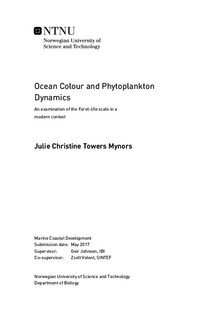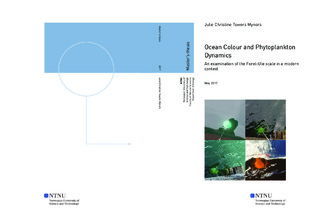| dc.description.abstract | The Forel-Ule scale as a method of determining ocean colour has been in use for over 100 years. Ocean colour is a result of inherent optical properties (IOP) in the water, including phytoplankton biomass, coloured dissolved organic matter and total suspended particulate matter. The Forel-Ule ocean colour scale (a 21 colour comparator scale for categorising ocean colour) was used in conjunction with modern optical instruments and methods to detect apparent optical properties (AOP) and IOP of seawater through a spring bloom period. Measurements were also done in order to evaluate the Forel-Ule scale for use in modern science, both as a tool for scientists, and for citizen science. The spring bloom period for which measurements were done was found to have two separate phytoplankton blooms of different phytoplankton compositions. The two blooms were found using all modern methods, but the Forel-Ule numbers and Secchi depth showed no such trend. However, a way of isolating the part of the Forel-Ule number not determined by the Secchi depth was found by subtracting the Forel-Ule number and Secchi depth measured from the maximum Forel-Ule number, 21. This factor, named the Forel-Ule No Secchi (FUNS) factor, showed the two blooms found during the spring bloom period, indicating that it might be determined by the concentration of Chlorophyll a to a greater degree than is the Forel-Ule number. The Forel-Ule scale is found to be the most useful in the interpretation of large-scale observations of ocean colour, for example from remote sensing, for creating maps of oceanographic information, and in connecting historical ocean colour data with present-day ocean colour measurements. However, the scale was found to be of less use in citizen science due to variation in results recorded by different individuals. In addition there were large differences between results when using the plastic Forel-Ule scale and the smartphone applications intended for use in citizen science. | |

